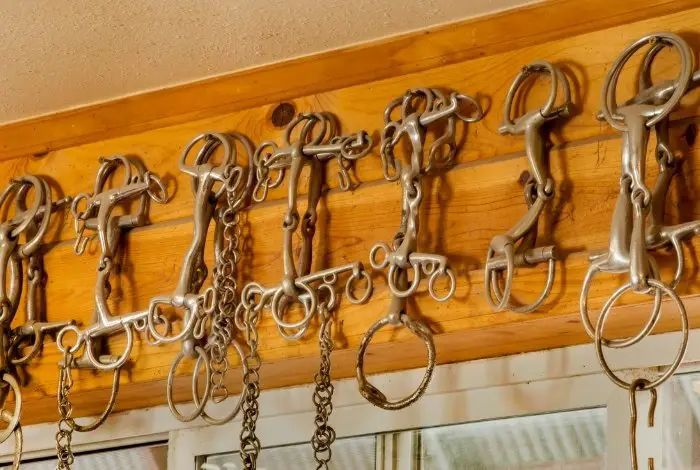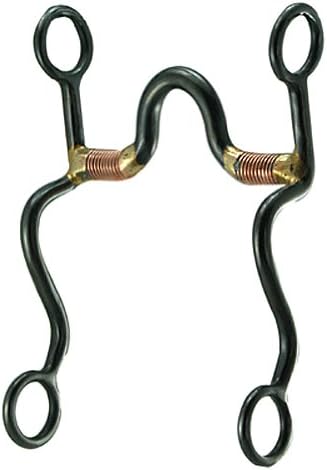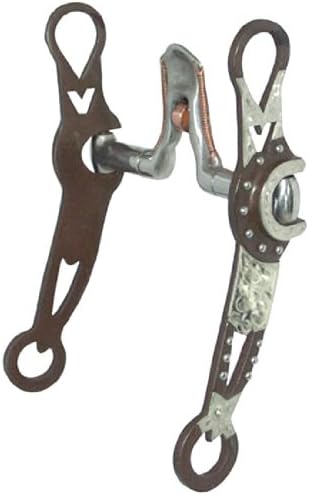Last Updated on February 9, 2022
Bits as a general topic can be extremely overwhelming, even addressing types of western bits. There are hundreds of industry-standard bits on the market, with endless variations depending on a horse or rider’s preferences. Although the types bits discussed here are more common western bits, keep in mind there are unlimited variations. There is also a multitude of bitless and combination options too!
Types of Western Bits
The lack of industry standards in the equestrian community leaves experts arguing over specific tack characteristics and qualities. The actual dictating source for discipline-specific bits is from competition organizations.
At home, a rider may choose to ride in a jumping saddle with a grazing curb bit (shown below), or a pelham and roping saddle. However, competition groups have rules and regulations, setting the standard for bit categorization. There is some historical and functional significance as well, especially in reference to single-hand western riding styles.
It isn’t possible to swing a rope out of the gate while juggling two sets of reins in a double bridle! As a basic overview, we will categorize the types of western bits as curb bits– bits that have shanks and operate on a curb chain and poll pressure.
But What About Snaffles?
Referencing “western” specific bits generally implies a style of shanked bit, but it would be irresponsible to leave the snaffle category out of any discipline.
Finished western horses typically use curb bits, but most horses begin in snaffle bits due to their simplicity and direct rein cues. Unlike curb bits, snaffles do not operate based off of poll pressure or leverage. Snaffle bits are very versatile and come in a multitude of variations.

Mouthpieces can be single or double-jointed, smooth or twisted, and use different rings. Many include different metals such as stainless steel, copper, or sweet iron. Although there are popular western bits with jointed mouthpieces referred to as “shanked snaffles”, these are not true snaffle bits (see Argentine Snaffle below). Snaffle bits do not technically offer any leverage.
Grazing Bit
Grazing bits are one of the most popular curb bits available. They have fixed shanks with a slight curve and typically feature a low or medium port. Although horses should not eat in the bridle, the name comes from the curved shank pieces that allow a horse to “graze” while bridled. Popular variations include copper or sweet iron mouthpieces to increase salivation and fun decorative shanks. This is a bit for finished horses that neck rein.
Correctional Horse Bits
A correctional bit is a training bit only meant for use by advanced riders. When engaged, the mouthpiece applies pressure to the tongue and bars of the mouth. Although the high port does provide some degree of tongue relief, it can also have a “nutcracker” effect on the roof of the mouth. In the wrong hands, this bit can make problems worse (rather than correct them), and create a “hard-mouthed” horse.
Tom Thumb
The Tom Thumb- an extremely popular and basic horse bit, used by many and recommended by few. Tack store owners and trainers alike say this tends to be the number one pick among new horse owners, but both are perplexed as to why.
Sometimes called a “western snaffle”, this bit has a single joint mouthpiece that creates a nutcracker effect when engaged. The Tom Thumb has medium to long straight shanks and provides no “pre-signal” to the horse before fully engaged. It works off both direct pressure and leverage, and can extremely severe. A common nickname is the “no-purpose” bit.
Junior Cow Horse
Junior cow horse bits are a particularly popular option for various rodeo events. It can be a single or double joint, frequently with a center “dog bone” or copper roller. Mouthpieces are smooth or twisted and frequently made of sweet iron or another metal for salvation encouragement. It features short contoured shanks and slight gag action, as seen on in the small circular cheekpieces. It works both on poll pressure and the horse’s lips.
Argentine Horse Bits
Argentine bits, referred to as Argentine snaffles (we warned about the verbiage confusion!), are lower leverage shanked bits with a broken mouthpiece similar to a snaffle. Unlike the Tom Thumb, Argentines have a slight contour in the shank and can utilize two sets of reins. These are a popular choice for horses that may be transitioning from a regular ring snaffle or horses that may still need some direct rein aid and pressure. Argentines are in the same family as Tom Thumbs (although not as severe), and have multiple variations.

Gags
Although you won’t see these in the western show ring, gag bits are commonly utilized in speed events such as barrel racing and for training purposes. Some are “sliding” gags with a mouthpiece that moves on a rope or cable, while others have a shank that connects directly to a ring.
Gag bits create lateral leverage and work well for elevating horses in abrupt turns. One of the most popular designs is a wonder bit- a modified gag with a slight shank. The floating mouthpiece allows some pre-signal before the curb and mouthpiece completely engage on the horse.
Spades
Spade bits are complex and advanced, only for the most skilled riders and highly trained horses. In vaquero tradition, they are a final stage in training- as many finished bridle horses won’t ever make it to a spade bit. It takes 5-7 years of extensive training to prepare a horse for a spade bit. Spades are highly decorative, and a work of art. They have straight ornate shanks, a straight bar mouthpiece, and a high narrow port with cricket and spoon supported by braces on each side.
The spade functions primarily inside the mouth, rather than on the mouth corners or from curb pressure. A horse must learn how to hold a spade bit properly in their mouths- a slight flutter of the finger is more than enough to signal a properly trained spade-wearing horse.
Closing Thoughts
The world of bits may be overwhelming at first, but a basic understanding of bit mechanics can help you choose the right bit for your horse. There is a vast market of western bits, but you will likely become familiar with a specific category depending on your chosen discipline. If you are competing, make sure you read your organization’s bit rules and regulations. In fact, many show employees a “bit checker”- someone tasked solely with checking horse bits! Be sure to also check out these English bits here.
Have friends with horses? Be sure to share this article!
FAQs
How do you know what type of bit to use on a horse?
The best way to find out what size bit you need is to measure the width of the horse's mouth. When you have your bit size figured out, you can try it on the horse. Remember that the bit should not stick farther than 1/2 inch out of the horse's mouth. You might need a small bit for a small horse, or a large bit for a large horse.
What is a Tom Thumb bit?
Indeed, the Tom Thumb bit is a snaffle bit for the western horse. Snaffles are mouthpieces used to control horses. A snaffle bit, as its name suggests, is a bit that has two prongs, one at each end, which are joined by a joint. The joint is either a metal or plastic cap. The Tom Thumb bit is considered an advanced bit because it requires a lot of training and practice to be able to use it effectively. The Tom Thumb bit is made up of a long metal or plastic shank with two prongs, or tips, at the end. There is also a joint in the middle where the prongs join. The mouthpiece of the Tom Thumb bit is very similar to the mouthpiece of a snaffle bit.
What is the most comfortable bit for a horse?
The most comfortable bit for a horse to wear at all times is the mullen mouth. The advantage of a mullen mouth is that it is less likely to be accidentally dislodged from the horse's mouth than other bits, and it is also the bit that allows for the greatest control of the horse's head movement. When choosing a bit, the first thing to consider is the horse's comfort level. The Mullen Mouth is the most comfortable bit many horse owners have ever tried. The horses normally never dislike it, even when training them. The second thing to consider is how much control you want over your horse's head. If you're looking for the most control, then a jointed bit will work best for you.
What is the easiest bit on a horse's mouth?
The most common bit on a horse's mouth is the snaffle bit. This bit can be a single cheekpiece or double cheekpiece with a single ring or two rings. The snaffle bit is a bit that gives you the best control and comfort on the horse. The double cheekpiece allows for more pressure to be applied to the horse's mouth. The single cheek piece gives you the most amount of control and comfort.
The most gentle type of bit is the eggbutt. It has an egg-shaped connection between the mouthpiece and the bit-ring. Although it is the gentlest type of bit, it still gives you enough control and comfort. It does not pinch the corners of the horse's mouth like some other bits. It has a more rounded tip that is comfortable on the horse's mouth.
What is a Western correction bit?
Western bits were developed during the 1800's and early 1900's when horse trainers used bits to force their horses to do certain things. They were called "Western" bits because they were most often used in the western part of the United States. A bit is an instrument used by a trainer to control and direct a horse. Bits were used to train and exercise horses for many purposes. Correction bits are used to correct and punish horses that do not respond correctly to commands given by their handlers.
Equestrian, Marine Corps vet, and Morgan horse enthusiast.






